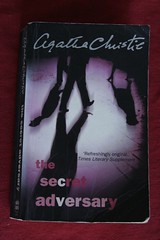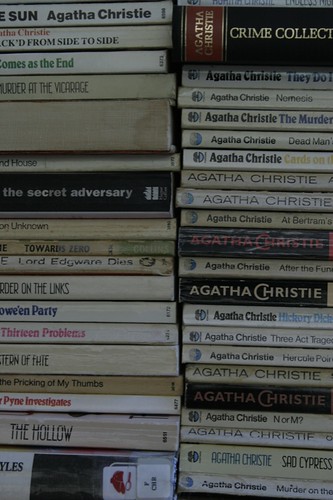2 - The Secret Adversary (1922)
Featuring: Tommy and Tuppence, Inspector Japp (mentioned)
KATHRYN SAYS: I think it’s fascinating that Agatha Christie is now best known as a writer of Miss Marple and Hercule Poirot murder mysteries, and here we are at book two at the Agathon and it’s a spy novel!
‘The Secret Adversary’ opens with childhood chums Tommy Beresford and Tuppence (Prudence) Cowell running into each other in London. World War I is over and there is a dearth of jobs for both ex-VAD women, like Tuppence, and ex-Army men like Tommy. They decide to form a joint venture the "The Young Adventurers, Ltd.", and hijnks ensue, as they are become embroiled in finding a missing American girl and tracking down a spy ring that is threatening to bring down the British Government. Even though I had already read it before, I found it quite exciting.
 Is it a good spy novel? Well, given what I’ve read of John le Carre and Frederick Forsythe (who to be fair did write about the Cold War, whereas this is between WWI and WWII), I’m not sure it’s a particularly accurate one. Other than Mr Brown, the villians are cardboard cutouts -there’s a Russian and a German and a man from The Union (gasp!), and an Irishman from Sinn Fein. I have no idea how it actually relates to the politics of the time, but it comes over as a bit simplified. However, the level of detail in the political, erm, plot, contrasts signficantly against those parts of the novel that are rendered in lovely detail, such as the very detailed and specific description of how Tuppence went about posing as a maid for Rita Vandermeyer (and her qualifications for doing so). And, at the heart of this very jolly spy book, there is a murder and a mystery and Christie weaves these both into the story very well (though perhaps with a few less red-herring-y clues as in a Poirot novel). I also have to note that I *love* that this is a spy book where eating is important! Tommy and Tuppence are continually sitting down to buns or a good lunch of sole (particularly once they are ensconced at the Ritz).
Is it a good spy novel? Well, given what I’ve read of John le Carre and Frederick Forsythe (who to be fair did write about the Cold War, whereas this is between WWI and WWII), I’m not sure it’s a particularly accurate one. Other than Mr Brown, the villians are cardboard cutouts -there’s a Russian and a German and a man from The Union (gasp!), and an Irishman from Sinn Fein. I have no idea how it actually relates to the politics of the time, but it comes over as a bit simplified. However, the level of detail in the political, erm, plot, contrasts signficantly against those parts of the novel that are rendered in lovely detail, such as the very detailed and specific description of how Tuppence went about posing as a maid for Rita Vandermeyer (and her qualifications for doing so). And, at the heart of this very jolly spy book, there is a murder and a mystery and Christie weaves these both into the story very well (though perhaps with a few less red-herring-y clues as in a Poirot novel). I also have to note that I *love* that this is a spy book where eating is important! Tommy and Tuppence are continually sitting down to buns or a good lunch of sole (particularly once they are ensconced at the Ritz).After Tansy noted Hasting’s propensity for ill-advised love in her review of ‘The Mysterious Affair of Styles’, it dawned on me that Agatha Christie books actually have a fairly high romance quotient. Two books in and we are two for two on ill-advised marriage proposals, for example. I’ll be keeping an eye out for more romance in books to come. I don’t want to include spoilers for ‘ The Secret Adversary’, but I will note that Christie writes the sort of Repressed English Love that made me so fond of Mr Darcy and Elizabeth Bennett, and this certainly something interesting to realise about both myself and Agatha.
So. In summary I love Tommy and Tuppence - or perhaps more accurately I am fond of Tommy and I love Tuppence (I have failed to wax lyrical about Tuppence’s independence and initiative, but yea she is awesome). Christie only wrote 5 Tommy and Tuppence books (4 novels and 1 short story collection) over 50 years, approximately one every decade and one of the things I’ve been looking forward to particularly in the Agathon is reading them in order, and watching how the characters grow and age with each book. I would love to know what prompted her to write about Tommy and Tuppence in her second book, after having made what appears to have been a promisinig start with Poirot in ‘Styles’ (if anyone can point me towards a good biography of Christie that tells me this, please leave comment!)
TANSY SAYS: Hijinks ensue indeed. This novel is utterly bonkers! It feels more like a screwball comedy than a mystery or spy novel, and I find it fascinating that once again we are getting meta-commentary about genre conventions from Christie in the mouths of her characters - in this case I was particularly charmed by Tommy’s ruminations on how hard it was to follow a person in a cab in real life, as opposed to the cinema!
The first quarter of the plot is so entirely dependent on crazy coincidence that I got the feeling that Tommy and Tuppence were both completely aware that they were in a novel, and determined to make the most of it. Halfway through the story, though, the banter and the jolly japes become rather grim in a scene which makes it clear (or did at least to me) that one of two people our rapscallion heroes have in their confidence is actually a bad un - and very cleverly, the novel twists back and forth on the question of which right to the end.
I’m glad we had this interesting point, because otherwise the disastrously long separation between Tommy and Tuppence threatened to bore me - Tuppence remains interesting when her partner in (solving) crime is absent, but Tommy rather less so, except when he is talking about Tuppence.
But oh - I wouldn’t have cared if the plot was ten times duller than it is, not when these two are around with their suppers at the Ritz and their pound notes, and simmering affections below banter and bluff. I’m rather sad to know that I won’t get to see *this* Tommy and Tuppence, the careless twenty-somethings on the verge of real life, in future books, but I am terribly interested to see how they grow up.
As a side note, I love the fact that this novel is so deeply rooted in its time - from the Lusitania to the war history of our heroes (Tuppences wartime career is hilarious in the detail she recounts) and all manner of other social detail. I always find it fascinating to read novels that feel like historical novels - that is, are aware of things which people would later find of historical interest, if that makes sense.
Also, I’m pretty sure that significant chunks of this novel were pinched for a Trixie Belden plot. Just saying.
COMING UP SOON:
3. The Murder on the Links (1923)
Hercule Poirot, Arthur Hastings
4. The Man in the Brown Suit (1924)
Anne Beddingfeld, Colonel Race
5. Poirot Investigates (1924)
A short story collection! (presumably involving Poirot :-)
